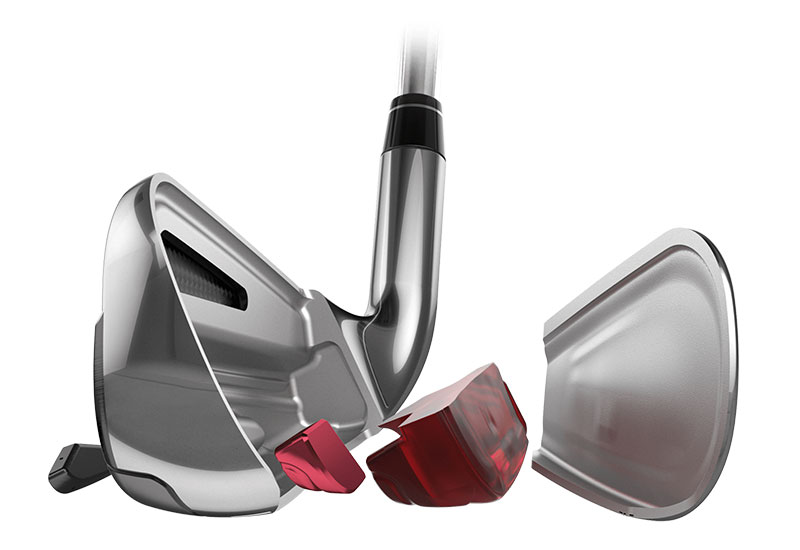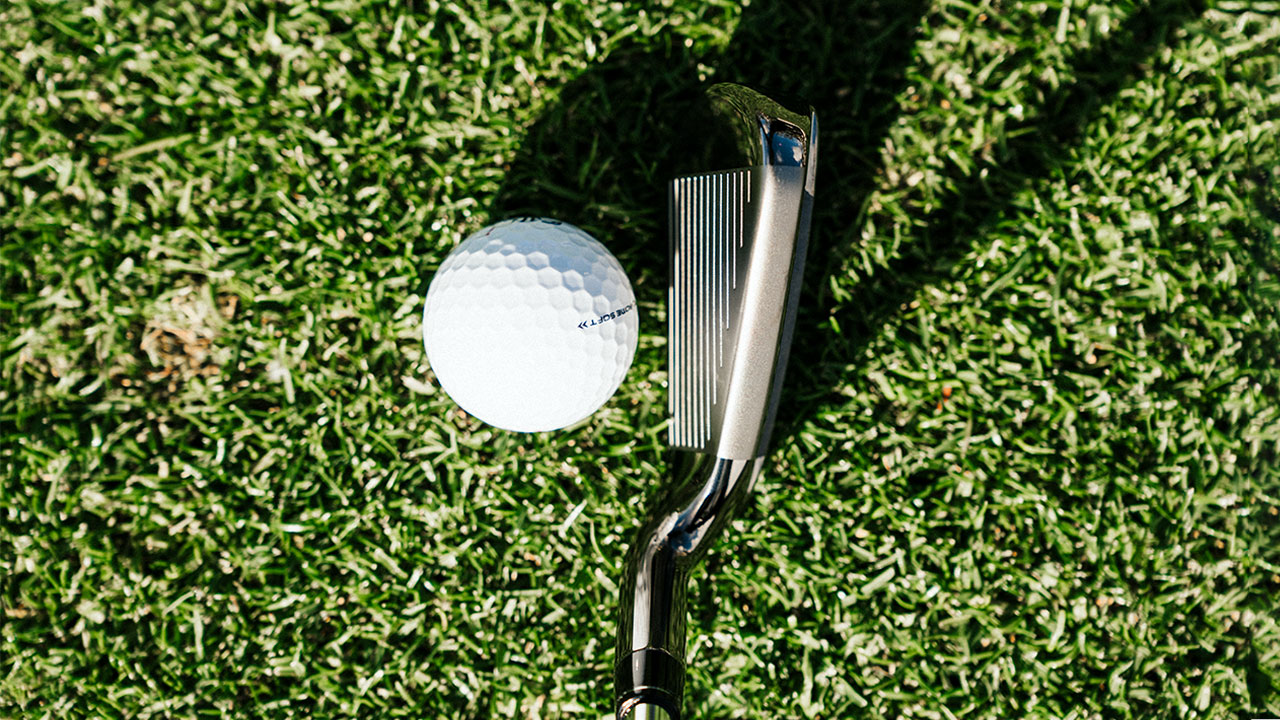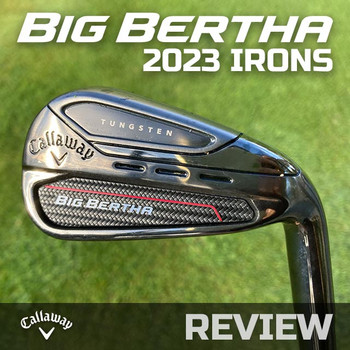Callaway BIG BERTHA Irons 2023 - Review
Posted by Jamie Martin on 28th Apr 2023
There’s nothing subtle about Callaway’s new Big Bertha irons.
They’re massive. They’re chunky. And they’re super practical.
They are the golfing equivalent of your dad’s New Balance sneakers.
My advice? Don’t knock them until you try them. And that applies to the irons and the footwear.
Australian Release Date: 12/05/2023
BIG BERTHA IRONS: BIG AND BEAUTIFUL?

If you haven’t got the memo yet, big is beautiful in the game improvement iron category. Truth is, I’ve always found game improvement irons just too big, ungainly and a little unattractive.
But the new 2023 Big Bertha iron might’ve almost — and I emphasise, almost — converted me.
BIG BERTHA: THE TECH
With their hollow-bodied design, Big Bertha irons contain an All-Star roster of technical know-how.
In short, if Callaway had it, Big Bertha got it. The A.I.-designed face cup has been seen in Callaway’s other irons but it’s been tweaked for Big Bertha. It escalates ball speed, which is a handy attribute for a distance iron.
Big Bertha irons also feature 54g of tungsten weighting spread over two zones.

Zone A is the perimeter of the club head, where the tungsten aids forgiveness and stability.
The tungsten in the larger Zone B is uniquely positioned inside each iron head according to loft and lowers the centre of gravity to varying degrees.
It is supposed to, you know, make the long irons launch higher and dial up more control in the short irons, that sort of thing.
Then there is the wad of urethane microspheres which hold the whole thing together.
In reality, Callaway’s microspheres are basically thousands of tiny air bubbles trapped inside a slab of rubberised plastic.
It helps support the face while elevating feel at impact by absorbing vibrations, regardless of where shots are struck on the club face.
HOW DO THEY LOOK?

There is a lot of meat on the Big Bertha bone — wide sole, thick top line and a hefty head volume — and it can prove a little tough to digest, all at once.
Club designers are compelled to tread a fine line between all-out performance and aesthetic sensibility.
The more an iron looks like a hybrid, the better it should theoretically perform for higher handicappers.
However, the shelf appeal of an iron diminishes in direct proportion to its degree of hybrid-ity.
In other words, the more juice injected into an iron, the less appealing the squeeze is for its target golfers.
Back to the Big Bertha.
While it wasn’t in the Wilson Launch Pad league, sophistication clearly ain’t Big Bertha’s strong suit.

The offset blade length dwarfed the ball at address. The rear profile contained near-hybrid levels of mass. And the top line of the Big Bertha looked like it could shore up the hull of an AUKUS-era sub.
But the performance? That was another story.
BIG BERTHA IRONS: SHOTS FIRED
Big Bertha irons might fly fairly close to the sun on the optics front. And their feel can be best described as hybrid-y, along with responsiveness bordering on ambivalent.
But, my goodness, they are long. Flushed out of the screws, shots flew miles and launched incredibly easily.
Based purely on speed, distance and launch out of the centre of the face, Big Bertha irons receive full marks.
In fact, it’s what you should expect with that much tungsten rolling around inside a hollow-body iron.
The tungsten injection means Big Bertha aren’t lightweight irons by any stretch and they were quite cumbersome to manipulate — it felt like I was trying to change the course of a cruise ship sometimes.
However, game improvement irons like the Big Bertha are ultimately judged by how they perform on mis-hits.
DOING BIG BERTHA THINGS
A short hosel, extremely wide sole and a considerable amount of offset on the face were the characteristics that initially caught my eye looking down at the iron at address.

And it’s these traits that largely explain the principles behind Big Bertha irons — righting the ball-striking wrongs of higher handicappers.
Minimising the hosel length helps to lower the centre of gravity and the wide sole fights a rearguard action against chunking by smoothing the way for the leading edge while helping to flight the ball high off the face.
One of the more impressive aspects was the way the irons dealt with low strikes on the face.
Even out of the bottom two grooves, it just didn’t seem like knifed bullets were in the Big Bertha vocabulary.
I felt you could really get aggressive through the ball and, much like trusting the bounce on a wedge, simply rely on the sole to do its job — and that in itself is a massive confidence booster.
As a golfer who generally hits a draw it took some time to get adjusted to the offset, which is there to help slicing golfers square the face at impact.
High-toe shots off the admittedly massive face were short circuited, with a much straighter flight coming through the irons’ immense forgiveness.
It did feel as though my hands were well in front of the ball at impact and I was soon hitting little hold-off fades in a bid to keep the face from turning over too early.
I don’t think there’d be much grumbling or backlash if a robustly consistent, line-holding fade was Big Bertha’s go-to shot for a player with over-active hands.
But that’s missing the point of the irons.
They weren’t really made for me. There was no sleek elegance. There was no agility. There was little shot-shaping capacity.
Big Bertha irons are made to do Big Bertha things, for golfers who need it most.
And that is to make the game easier by incorporating the latest technology in the game.
BIG BERTHA IRONS VS PARADYM X IRONS
An A.I. face cup, urethane microspheres and a truckload of tungsten both feature in Callaway’s new Big Bertha and Paradym X game improvement irons.
So what’s the difference?
The Paradym X has a smaller head, its sole isn’t as wide and topline isn’t as thick as the Big Bertha.
And Paradym X irons also have more tungsten, less offset and slightly weaker lofts compared to Big Bertha irons.
Think of Big Bertha is Callaway’s most battle-ready game improvement irons, with the Paradym X a slightly smaller and nimble game improvement iron.
BIG BERTHA IS BACK… AGAIN
Big Bertha is Callaway’s game improvement line and the new 2023 range continues its tradition of providing players who need the help, with the help they need.
While it’s left in the shade by the star power of Paradym and the like, Big Bertha should really breathe the same rarefied air.
The ranks of beginners are surging and the Big Bertha range appeals as an ideal way to kick off your golfing journey.
Read the review of the Callaway Big Bertha driver here.
THE VERDICT
HIGH FIVES
• Easy to launch and amazingly long
• Low strikes performed superbly
• Wide sole optimises higher lofted clubs for chipping
• Carbon fibre detail on rear cavity is a cool touch
BUMMERS
• Head is heavy and clunky
• Sounds like a hybrid
• Response and feel is vague
WHO WILL IT SUIT?
- High handicappers and beginners. Golfers who need help getting the ball airborne. Players with an inconsistent strike pattern.
SIMILAR CLUBS
- TaylorMade Stealth HD
- Paradym X
- Cleveland Launcher XL
- Wilson Launch Pad
CALLAWAY BIG BERTHA IRON SPECIFICATIONS
- Australian Release Date: 12/05/2023
- Hand: RH/LH
- Shaft: Callaway RCH graphite (65), True Temper Elevate 85 MPH steel
- Grip: Callaway Universal
- 2023 Callaway BIG BERTHA Iron Lofts: 4 (18°), 5 (21°), 6 (24°), 7 (27°), 8 (31.5°), 9 (36.5°), PW (42°), AW (47°), GW (52°), SW (56°)

|
Written by Jamie Martin Jamie Martin is currently locked in a battle to keep his handicap hovering around the mid-single digits. Despite his obvious short-game shortcomings, Jamie enjoys playing and writing about every aspect of golf and is often seen making practice swings in a mirror. |

